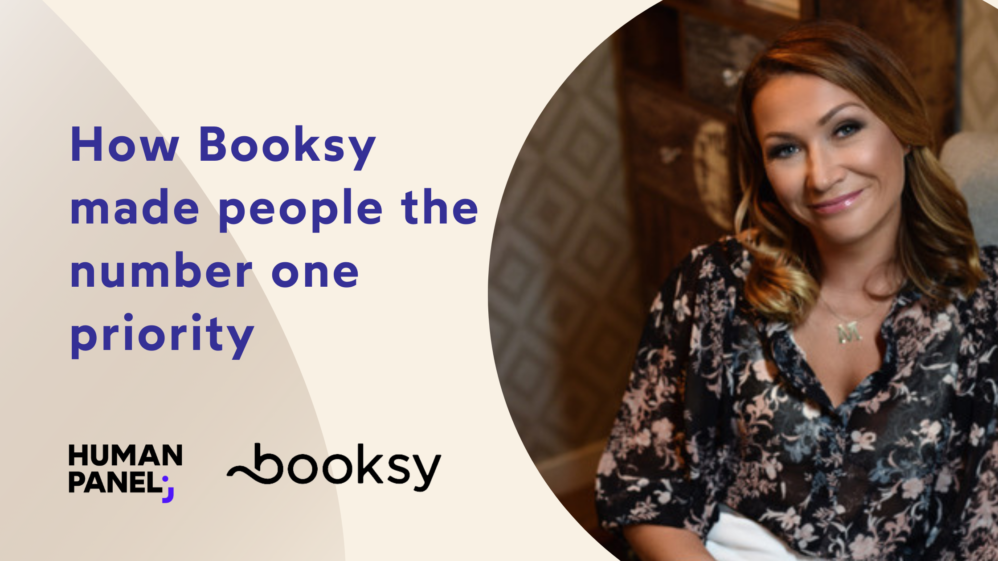What CEOs can do to avoid Great Resignation

Executives worldwide are concerned about the Great Resignation but are they looking at the right data? Let’s explore who exactly has been driving this trend and what CEOs and HR leaders can do about it.
Have you lost some high-performing employees recently and are you struggling with high turnover? It may be due to the tide of resignation that has gripped labor markets in the US and Europe.
According to the US Bureau of Labor Statistics, the number of job openings reached a record 10.9 million in July 2021. In August, more than 4.3 million Americans quit their jobs. In the UK, the number of open openings went over 1 million for the first time in history. Employers struggle to retain employees and have difficulty filling vacancies.
Experts have dubbed this phenomenon “the Great Resignation”, and observe it globally – from the Netherlands to China.
If you are an employer, you might fear that the tidal wave of people leaving work will impact your business. That’s a reasonable assumption, but the reality – as usual – is more complex, and researchers are discovering more variables as they continue to collect data. Besides, there’s a lot you can already do in your business to retain your best employees, regardless of the Great Resignation.
What is the Great Resignation?
First, let us examine what the Great Resignation is and what causes it.
At the beginning of 2021, America saw an unprecedented number of people quitting their jobs. According to the US Department of Labor, 2.7% of the US workforce quit in April 2021, the highest number ever recorded at the time. Since then, that figure went up even further, with 2.9% of the US workforce quitting in August 2021. Paradoxically, this occurred despite labor shortages and high unemployment in some sectors of the economy.
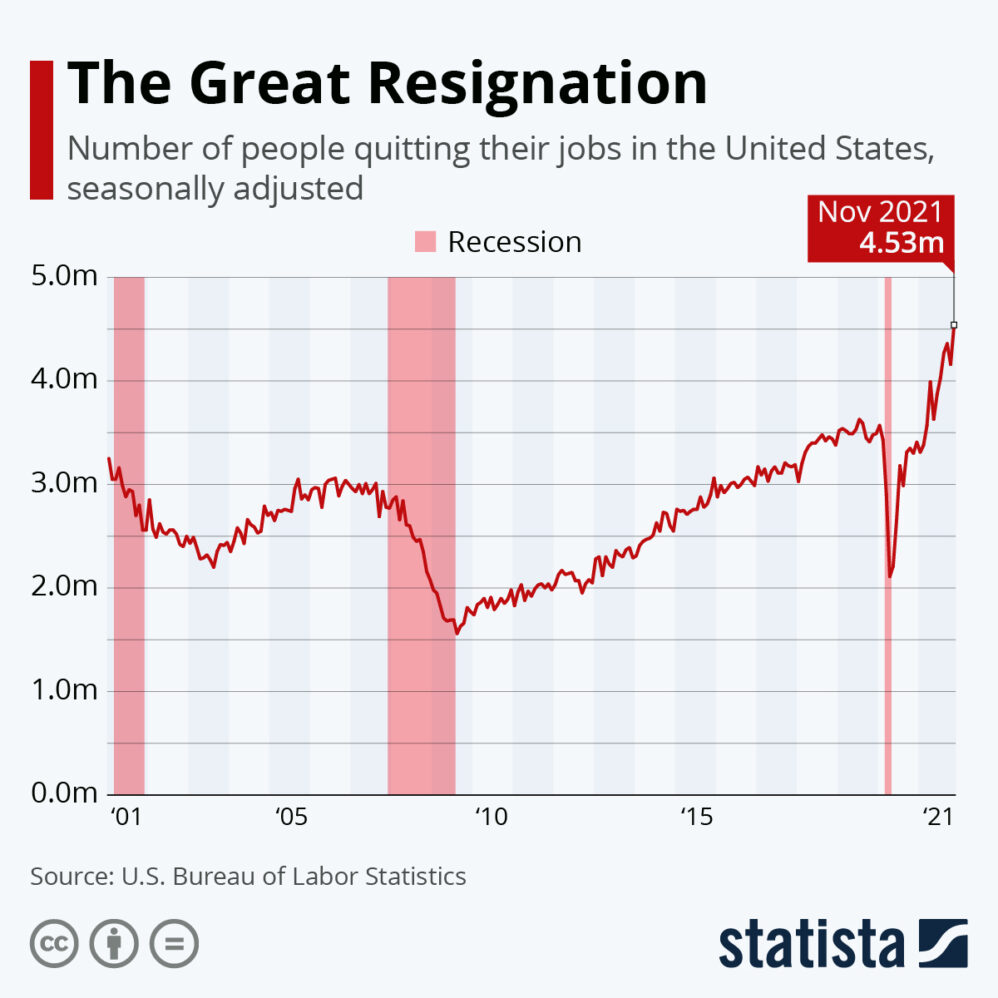
Professor Anthony Klotz from Mays Business School at Texas A&M University was the one who called this mass exodus “the Great Resignation”.
Experts believe the cause might be the COVID-19 pandemic itself. Many people had time to rethink their careers and working conditions. They began to value working from home and flexibility, which was the main reason for looking for a new job, according to a study by Bankrate. Another reason, which is particularly evident among younger generations – mainly Millennials and Generation Z – is the quest for a better work-life balance.
What does the data tell us about the Great Resignation?
But to understand the Great Resignation better, we need to take a closer look at the numbers. This could be a challenge because there is not enough data to calibrate the magnitude of the Great Resignation. The US government has only tracked resignations since 2000. Some experts note that the number of people leaving work was high even before the pandemic. The COVID-19 crisis only acted as a catalyst.
Despite the incompleteness of data, there are three factors that we need to consider in assessing the scale of the Great Resignation.
Who is “making headlines”?
First, let’s look at the available data and assess just how significant the trend is.
According to Jay Zagorsky, a lecturer in markets, public policy and law at Boston College’s Questrom School of Business, only less than 3% of workers quit today. More people say they are considering quitting, and those numbers are “making headlines.”
A Microsoft survey of more than 30,000 workers in 31 countries found that 41% of workers are thinking about leaving their jobs. In an August survey by Bankrate, 55% of Americans said they plan to look for a new job in the next 12 months. How many of them will actually leave their jobs is still to be determined.
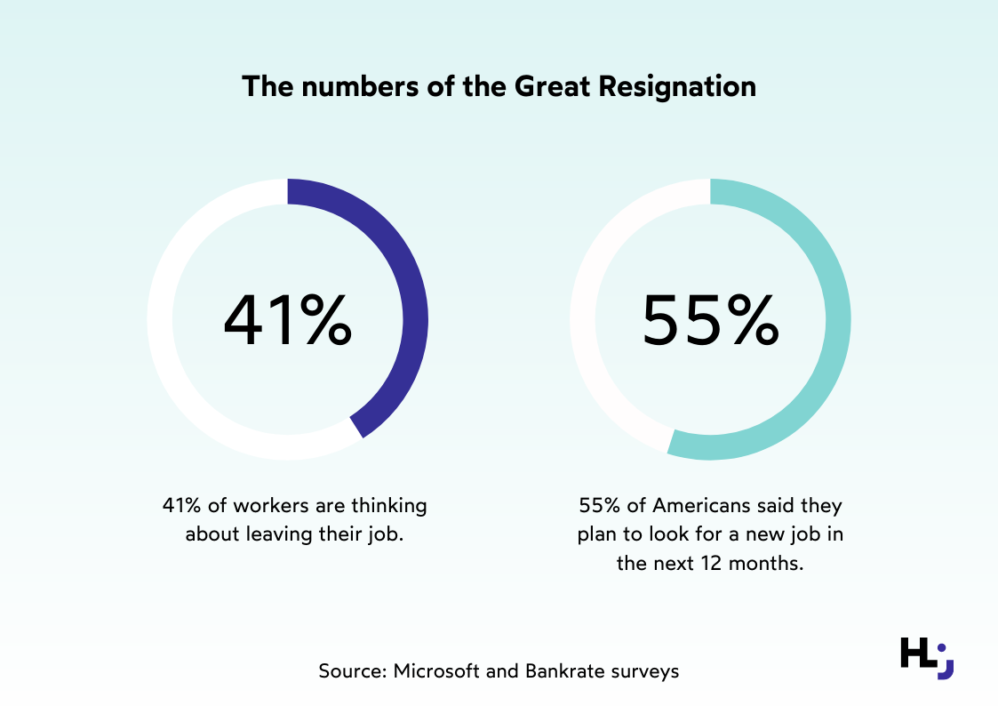
Who is quitting?
The second important aspect of the Great Resignation are demographic characteristics and motivations of people who quit their jobs.
Martha Maznevski, a professor of organizational behavior at Western College’s Ivey Business School in Ontario, said in an interview with BBC that there are two broad categories of those giving up their jobs.
The first are professionals who choose between “good” and “better” working conditions. The second are people who quit toxic, unhealthy organizations. This comes to show that the Great Resignation is driven by two different dynamics.
Ian Cook of the Harvard Business Review, who ran an in-depth analysis of more than 9 million employee records from 4,000 companies, notes that workers between the ages of 30 and 45 exhibit the highest quit rate. Those who really drive the quits are mid-level employees. Cook hypothesizes that there are several reasons for this behavior.

The reasons for the Great Resignation
The first reason is that the shift to remote work has led employers to perceive hiring employees with little experience as risky because they do not have the benefit of in-person training. This led to a greater demand for middle and senior managers, providing them with more employment opportunities.
On top of that, the uncertainty caused by the pandemic delayed promotions and transitions for these mid-level employees, prompting them to seek new career opportunities.
The final reason is that workplace flexibility has become a priority for this group. According to PwC’s Workforce Pulse Survey and Microsoft’s WTI report, flexibility is more important than a higher salary to more than a half of Millennials and Generation Z.
Which industries have been affected the most?
It is also worth examining which industries are most affected by the Great Resignation. According to Ian Cook, the technology and healthcare industries are seeing the most resignations. On the other hand, the Bureau of Labor and Statistics found that the hardest-hit industries in September were leisure and hospitality, arts and entertainment, restaurants and hotels, trade, transportation and utilities, professional services, and retail.
Nick Bunker, director of economic research for North America at the Indeed Hiring Lab, notes that the number of layoffs in industries like financial services has only increased by 5% since February 2020.
The phenomenon seems to be complex then. Even Anthony Klotz acknowledged that “the causes of the Great Resignation are very diverse and manifest themselves in different ways.”
For some experts, “the Great Resignation” is an oversimplification. Not all who consider resigning do so, after all. They note that “you can only resign if you have a choice” – meaning that perhaps we see the Great Resignation through the eyes of those who have the privilege of quitting and have a financial cushion that allows for a potential career break.
Some business leaders, including LinkedIn CEO Ryan Roslansky and Microsoft CEO Satya Nadella, called the phenomenon “the Great Reshuffle” rather than “the Great Resignation”.
How to avoid the ”Great Resignation” in your company
Whether you are likely to be affected by the Great Resignation or not, you will need to fire up your employee retention strategy sooner or later. All the data from the job market and presented statistics mean you need to start retaining your employees now, and there are several ways you can achieve that.
Determine the turnover costs
The data-driven approach is critical if you want to determine not only how many employees are leaving, but why they are leaving, who exactly is leaving, who is at risk of leaving, and what you can do to prevent it. All these details will look different depending on your business, but you need the numbers to link HR goals to business KPIs and use data science to support your decisions.
If you are reading this, you probably know your turnover rate, which is a good starting point for the actual analysis. Now, you need to determine how attrition impacts your key business metrics. Every employee who leaves your company represents a significant cost. To fill the vacancy, you need to hire a new person, and the cost of hiring them can add up to the equivalent of several salaries.

Turnover costs are more than just the cost of hiring new employees,onboarding, and training. Attrition also includes the lost revenue or the lost value of transactions that could have been made if the employee had not resigned.
In addition, there are some intangible costs that you should factor in, such as the loss of expertise, know-how, skills, and resources.
Last but not least, an employee who quits can have a negative impact on the team’s morale, motivation and productivity. And if someone else has to take over the tasks of the departing employee, this means more work and more stress and pressure for those who stay.
Know your ROI
You should always know the actual cost of attrition. Why? Because it will help you determine the ROI (return on investment) of a predictive analytics project that addresses the problem of turnover. To see if your strategy is producing the desired results, you need to know how much you are losing to turnover and whether your initiatives are improving the situation.
Tip: If you do not know how to calculate your turnover rate and turnover costs, check out the personalized solution we offer at Human Panel. Sign up for a free demo and see what metrics you can track and how to get the most out of your HR data. Stop guessing and stop being frustrated – use the science behind the numbers and link your HR goals to business KPIs.
Ready to start people analytics with Human Panel?
Correlate turnover with other metrics
The next step in your analysis is to track how increased turnover correlates with other relevant metrics. Does it affect team productivity? What impact does it have on engagement? Identifying these correlations is critical today. According to the State of the Global Workplace report, employee engagement is 20% globally, while it’s slightly higher in the U.S. and Canada at 34%.
To reduce turnover, you need to know what is causing it. In this regard, you should look at metrics such as:
- Compensation
- Time since last promotion
- Salary increases
- Performance
- Learning and development opportunities
If you use people analytics software, you can segment your employees by categories such as location, function, and other demographics to understand better which groups are more prone to quitting. You can track turnover by job group, manager, tenure, and department to find out which groups are at the highest risk of quitting.
You don’t have access to relevant data and employee profiles? If your data is scattered across different systems and you can not reliably view it, contact us. We will be happy to help you with data cleansing and integration, as well as setting up a customized workforce analytics solution.
Here’s what it looks like at Human Panel:
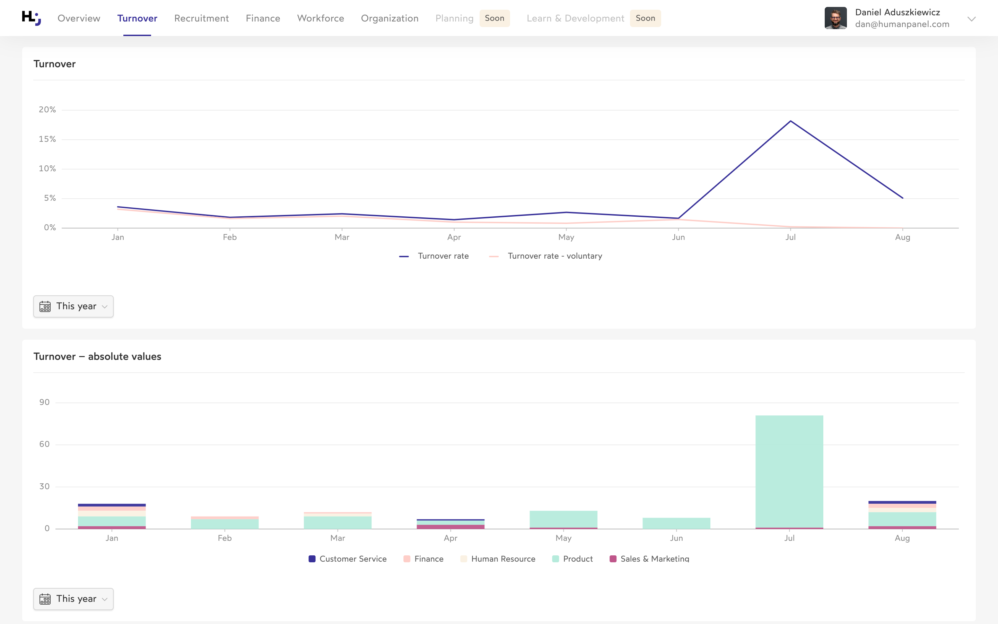
Apply surgical solutions to your pain points
Once you have identified at-risk groups and the most common reasons for turnover, you can act in two ways. First, you can develop tailored programs to improve employee retention. Second, you can predict further turnover to take a proactive approach.
It’s important to be proactive rather than reactive. If you own a large company, a 1-percent reduction in turnover might translate into millions of dollars in savings.
So, for example, if you find that women in their 30s are leaving your company at a faster rate than other groups, perhaps it’s time to overhaul maternity benefits? You might also find that retention is much better in some teams than in others. If so, a “stay interview” might be a good initiative. What is a stay interview? Rather than asking people who leave why they left, ask others what motivates them to stay – and also what you could do to improve the employee experience.
You may find – just like Netguru did – that you are losing employees to your competitors who offer much higher salaries. Salary increases can come at a significant cost, but you need to calculate them carefully and decide if you can afford not to give them.
Forecast future turnover
There are many models that help companies predict turnover and identify which employees are at risk. The goal of all these models is basically to predict the likelihood of an event occurring (e.g. voluntary departure) by analyzing predictor variables (e.g. employee satisfaction, performance, average monthly hours, number of projects, absenteeism rate, salary level, promotions in the last 5 years, seniority, manager, and department). Such an analysis can help predict who might leave the company so that a “risk score” of leaving is determined for each of your employees.
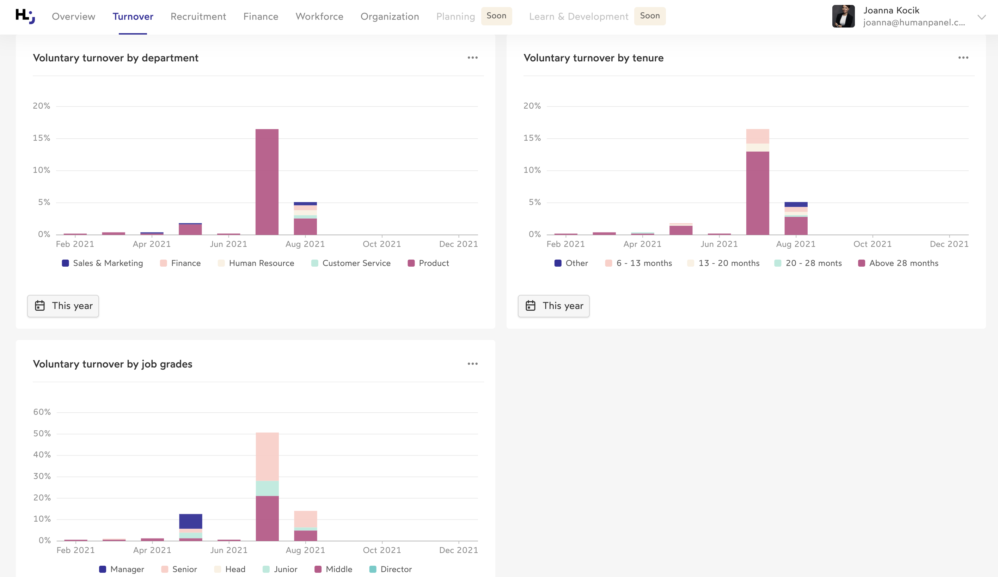
Any people analytics software can perform such an analysis. Furthermore, it can be customized depending on the data you have. That said, chances are you lack an efficient data infrastructure or your data is stored in multiple systems and sources, such as ATS, spreadsheets, or CRM. In such a case, you will need to integrate all data points first. If you want to run successful targeted employee retention campaigns and predict attrition, you need clean and reliable data.
When your HR data is scattered across different locations and you do not see any correlation between the different data points, there is a way to bundle your data and bring it together on one platform without any pain. If you want to have access to customized data dashboards in an easy-to-navigate platform, simply book a demo of Human Panel and see the difference. No analytical skills are required here – all information is presented in clear charts and graphs that anyone can easily interpret.
Battle-tested solutions
Many companies have already experienced breakthrough effects from turnover predictions. For example, they have discovered that employees leave the company even if they get promoted if the pay raise is not significant enough. Sometimes, turnover can be caused by privacy issues. In this case, access to demographic data is critical. Modern people analytics platforms grant the highest level of data protection and give full control over who has access to it.
Implementing a data-driven retention strategy can be challenging. But the question you need to ask yourself is: can you afford a higher turnover and a wave of resignations in your company?
With a little help from people analytics, you can measure turnover rates to see the extent of your problem, calculate costs, and determine the reasons why your employees are leaving. This will help you answer the questions that are critical to your business and implement an effective strategy. The results can be quite astounding – some companies find that the number of resignations in some teams has dropped by 10% after implementing data-driven tactics.
So, are you on board with this? If you need more information, check out all the features of the Human Panel platform. We’d also be happy to explain how we work and what else we can offer your business to keep a happy and productive workforce.


